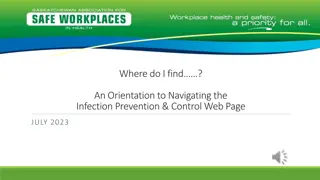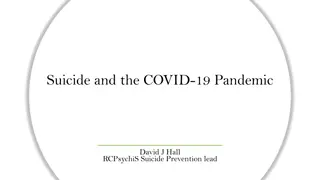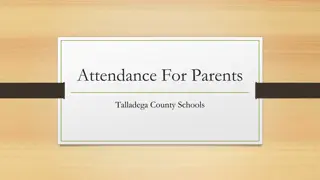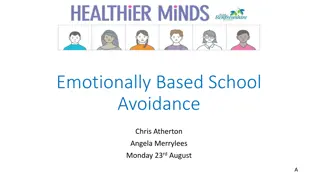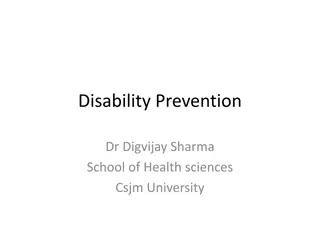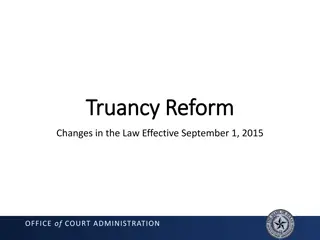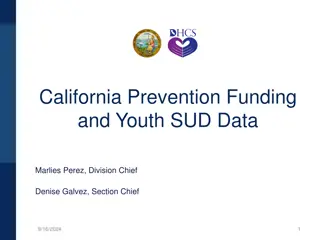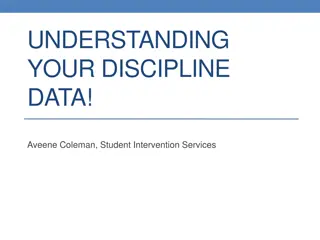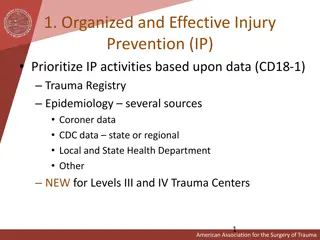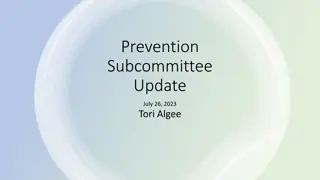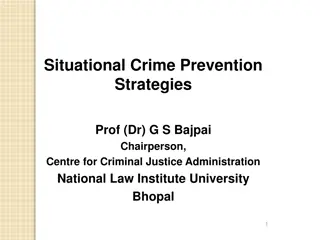Understanding Truancy: Prevention Measures and Procedures
Truancy is often a symptom of underlying issues affecting children, such as lack of resources at home, transportation needs, or personal struggles. This overview covers reasons for truancy, acceptable absence levels, chronic absenteeism criteria, campus interventions, and the process of sending attendance warning letters. It emphasizes the importance of identifying and addressing the root causes of truancy to support students effectively.
Download Presentation

Please find below an Image/Link to download the presentation.
The content on the website is provided AS IS for your information and personal use only. It may not be sold, licensed, or shared on other websites without obtaining consent from the author. Download presentation by click this link. If you encounter any issues during the download, it is possible that the publisher has removed the file from their server.
E N D
Presentation Transcript
Truancy Prevention Measures Procedures TPMS Truancy is only a symptom of a child in need identify the cause Home Lack of resources, parenting skills, domestic violence, homelessness etc School Transportation needs, conflict, bullying, learning difficulties, lack of supplies etc Personal Life of Child Medical, mental health, anxiety, death in family, abuse, no uniforms etc 1
ADA - Calibration 90% A 80% B 70% C 60% D 50% F 3
ADA Recalibration 96-100% A 93-95% B 90-92% C <90% F 4
Chronic Absenteeism *Missing 10% or more of the days offered through each grading period Elementary Cycle Elementary 10% Middle School Cycle Middle 10% High School Cycle High 10% 8/9/23 to 10/6/23 5 Days 8/9/23 to 9/15/23 3 Days 8/9/23 to 9/15/23 3 Days 10/10/23 to 12/19/23 9 Days 9/18/23 to 10/27/23 6 Days 9/18/23 to 10/27/23 6 Days 1/4/24 to 3/8/24 14 Days 10/30/23 to 12/19/23 9 Days 10/30/23 to 12/19/23 9 Days 3/18/24 to 5/23/24 19 Days 1/4/24 to 2/16/24 12 Days 1/4/24 to 2/16/24 3 Days 2/19/24 to 4/5/24 15 Days 2/19/24 to 4/5/24 7 Days 4/8/2024 to 5/23/24 19 Days 4/8/2024 to 5/23/24 10 Days 6
Campuses Provide the Recommended Campuses Provide the Recommended Layers of Documented Interventions Layers of Documented Interventions Attendance Clerk = 3 unexcused absences or excessive excused (Truancy Contact) Teacher = 5 unexcused absences or excessive excused (Truancy Contact) Counselor = 7 unexcused absences or excessive excused (Truancy Contact in Eduphoria ) AP, Principal, Committee = 10 unexcused absences or excessive excused (Complete a Truancy Prevention Measures CONTRACT) District audits implementation annually 7
Attendance warning letters are sent from FOCUS on set intervals. The letters are sent automatically via email to parents. Attendance Letters Sent From COC Via FOCUS 8
Truancy Letters sent on a 1 week delay and are sent on the day the threshold is met Initial Truancy Letter 3 U/X within a 4 week period (Elementary & Secondary) Final Warning Notice 7 U/X within a 6 month period (Elementary) Final Warning Notice 5 U/X within a 6 month period (Secondary) 9
Letters are sent at the first of each month and do not duplicate Elementary and Middle Schools Credit Warning 9 to 17 absences for the year Credit Loss 19+ absences for the year Credit Warning Credit Lost Letters High School Credit Warning 5-8 absences per class per semester Credit Loss 9+ absences per class per semester 12
Attendance Credit Warning Credit Loss Letters (90% attendance law) 13
Campus Based Truancy Prevention Measures (TPMS) are Mandated by the Texas Education Code Sec. 25.0915. TRUANCY PREVENTION MEASURES. (a) A school district shall adopt truancy prevention measures designed to: (1) address student conduct related to truancy in the school setting before the student engages in conduct described by Section 65.003(a), Family Code; and(2) minimize the need for referrals to truancy court for conduct described by Section 65.003(a), Family Code.(a-1) As a truancy prevention measure under Subsection (a), a school district shall take one or more of the following actions:(1) impose:(A) a behavior improvement plan on the student that must be signed by an employee of the school, that the school district has made a good faith effort to have signed by the student and the student's parent or guardian, and that includes:(i) a specific description of the behavior that is required or prohibited for the student;(ii) the period for which the plan will be effective, not to exceed 45 school days after the date the contract becomes effective; or(iii) the penalties for additional absences, including additional disciplinary action or the referral of the student to a truancy court; or(B) school-based community service; or(2) refer the student to counseling, mediation, mentoring, a teen court program, community-based services, or other in-school or out- of-school services aimed at addressing the student's truancy.(a-2) A referral made under Subsection (a-1)(2) may include participation by the child's parent or guardian if necessary.(a-3) A school district shall offer additional counseling to a student and may not refer the student to truancy court under this section, Section 25.0951, or any other provision if the school determines that the student's truancy is the result of: (1) pregnancy;(2) being in the state foster program;(3) homelessness;(4) severe or life-threatening illness or related treatment; or(5) being the principal income earner for the student's family.(a-4) If a student fails to attend school without excuse on three or more days or parts of days within a four-week period but does not fail to attend school for the time described by Section 25.0951(a), the school district shall initiate truancy prevention measures under this section on the student(b) Each referral to truancy court for conduct described by Section 65.003(a), Family Code, must: (1) be accompanied by a statement from the student's school certifying that: (A) the school applied the truancy prevention measures adopted under Subsection (a) or (a-4) to the student; and (B) the truancy prevention measures failed to meaningfully address the student's school attendance; and (2) specify whether the student is eligible for or receives special education services under Subchapter A, Chapter 29. 14
Truancy Contact Report - short form to be used for simple phone, SchoolStatus text message conversations or other interventions. Document Intervention in Eduphoria Truancy Prevention Measures CONTRACT a lengthier form that should be completed when a counselor, principal, assistant principal or committee meets with the family. This is required by law. The sooner this is completed the better. 15
Document your intervention Step 1: Log into Eduphoria Step 2: Select Aware Step 3: Select the Students tab on the left Step 4: In the Search Students box on the upper left, type in the student s id # or last name, first name (if the student is not enrolled type in INCLUDE UNENROLLED then type in the name or id#) Step 5: Select Search or press enter on your keyboard Step 6: Select the student when their name populates below Step 7: When the student name populates to right go to Forms Step 8: Select Add Form Step 9: Select Truancy and then select either the Truancy Contact Report whichis the simple form used for staff who are doing a short contact or the Truancy Prevention Measures CONTRACT form which is the more lengthy form that should be used when a committee or a principal meets with the parent. After you have selected the form you will use select Add . Step 10: The new blank form will populate at the bottom of the student s forms. Click on View for the one you just selected. Complete the form by providing as much info as possible. Make sure to SAVE after completing. 16
Frequently Asked Truancy Prevention Measures CONTRACT Questions Who can complete a Truancy Prevention Measures CONTRACT? A Principal, Assistant Principal, or a committee made up of two or more staff. Does the parent and student have to be present? The campus should make several documented attempts to have both the parent and student present. If you cannot get the parent present you may hold the conference via phone with the parent and student. You must indicate on the CONTRACT that the conference was held via phone. You must also let the parent know that you are filling out the CONTRACT and will send them a copy. How long is the CONTRACT period for? 45 school days. What is the purpose of the CONTRACT? To discover the reasons for the absences and to provide referrals to services to help improve the student s attendance. What are some common reasons for attendance problems and what referrals we should we make in the CONTRACT? Lack of parenting skills Free Parenting Wisely class at COC. Ask parent to call 456-8569 to schedule class Transportation Problems Transportation Department 456-9869 No clothing, uniforms or supplies COC social services 456-8569 Runaway behaviors Stay Together Program 1-800-922-STAY Substance abuse issues SAS Counselor on campus or Counseling Department at 456-8559 Child walking off campus Ask parent to shadow student for 2 days Questionable excuses from parent require doctors notes for future absences Grief or loss issues campus counselor and/or Rays of Hope 684-KIDS No parent involvement Ask parent to attend the next school based parent involvement activity Family appears to be homeless Contact the COC at 456-8569 COVID-19 related fears contact the school nurse or school counselor to discuss fears What do we do if we cannot get a parent s participation for the CONTRACT? If you have made several bonafide attempts to contact the parent and they refuse or you cannot get ahold of the parent, then document your efforts on the Truancy Prevention Measures CONTRACT in the narrative part. The efforts must be more than clerical staff making two calls. It is important to document if the parent refuses. If the parent says I m not agreeing to anything then document this in the narrative. If the parent hangs up on you, document that in the narrative. The court needs to know the parent is refusing to respond. If the contract expires and the student starts missing again must we do another CONTRACT? Yes 17
Legal Consequences FAQ When are truancy charges filed? 10 U/X within a 6 month period as long as there is a current Truancy Prevention Measures CONTRACT in Eduphoria. Who are the charges filed against? Parent 1 in FOCUS. What are the charges called? Parent Contributing to Non Attendance is a Class C Misdemeanor and can result in fines and other consequences including orders to attend parenting and other specialized services designed to help the family. How long does it take to get to court? Typically 2 weeks after the students 10th U/X. Do parents or students go to jail? Parents can be incarcerated for violating court orders. Students cannot be incarcerated. Can I find out where a student stands in the truancy process and what happened in court? Yes, call the COC at 456-8569. 22
What Works? Parents say they trust teachers the most to talk to them about their child s attendance. Parents underestimate and do not track the number of times their child misses school. Help them track their child s absences. Early attendance equals later success. Fact that education was sequential was new information to parents. Talk to parents about specific instruction the student is missing out on. Absences Add Up 2 absences per month = chronic absences. Parents do not realize this. What Doesn t Work? The Bad Habits Argument - Early absences equals later ditching. Parents think this message is too negative and say this does not apply to them and so they dismiss the message. The All Absences Are Equal Argument Parents think this message is unbelievable. They feel some absences are ok. 23
Promoting Attendance Through One-on-One Communications Regardless of whether you are conducting a parent teacher conference, paying a home visit or placing a phone call home, you can find ways to use this interaction to help parents understand the importance of attendance and what it means for how they support the school success of their child. Below are some suggestions. Review this list. Use your creativity to come up with other ideas. 1. Prior to meeting with or talking to the parent, take a look at this student s attendance record. Calculate the percent of days missed in school through the grading period. Note whether the student has Satisfactory attendance (misses 5% or less of class) Chronic absence (misses 10% or more of class) Severe chronic absence (missing 20% or more of class) 2. Offer positive reinforcement to those students and families with satisfactory or better attendance. 3. For those who are chronically absent, plan to discuss the importance of attendance and find out parents perspectives what is contributing to the excessive absences. Ask parents both about what makes it difficult to get to school. Find out if they can think of any positive examples of activities or supports that made it easier to get their child to school (whether that is, for example, an engaging classroom activity or when family members or friends are available to help drive or walk their child to school.) Discuss what would help to reduce the level of absences. Help them understand absences even if excused can harm their child s ability to learn and succeed in school. 4. If appropriate, consider referring the family to 2-1-1 to help the family obtain extra social and economic supports. 2-1-1 is an information and referral line supported by local United Ways in many communities across the United States. If you are on the phone, consider scheduling an in-person meeting or home visit during which you could have this discussion. 5. Share handout offering research on the importance of attendance and tips for how parents can ensure students attend school every day. If this is a phone call, consider mailing the handout to the parent as part of a follow-up communications. 25
WHAT TO SAY TO PARENTS OF YOUNGER CHILDREN (ELEMENTARY SCHOOL) Families can make a difference. From a child s first day of formal schooling, the family can set the expectation that school attendance matters to you and that you won t allow an absence unless someone is truly sick. We understand that children will get sick and need to stay home occasionally. The important thing is to get your children to school as much as possible. People tend to grow concerned only about students who miss consecutive days of school, but occasional absences can be just as disruptive as they can add up before you know it just two to three days a month can add up to nearly 10 percent of the school year. Attendance matters as early as kindergarten. Studies show many children who miss too many days in kindergarten and first grade can struggle academically in later years. They often have trouble mastering reading by the end of third grade. Preschool is a great time to start building a habit of good attendance. Studies show that poor attendance in preschool can predict absenteeism in later grades. For younger children, parents can set a regular bed time and morning routine. Make sure they get 9 to 11 hours of sleep. You can lay out clothes and pack backpacks the night before. Get to know your children s teachers and administrators. With younger children, make sure you introduce your child to teachers before school starts and keep in touch with the teachers. Remember you can turn to the school for help. Many schools offer services for the whole family to help, for example, with issues concerning access to health care and reliable transportation. 26
WHAT TO SAY TO STUDENTS (Secondary) School is your first and most important job. You re learning about more than math and reading. You re learning how show up for school on time every day, so that when you graduate and get a job, you ll know how to show up for work on time every day. When you re not here, we notice because we care and we want you to be successful. Students who attend school regularly are more likely to graduate and find good jobs. In fact, a high school graduate makes, on average, $1 million more than a dropout over a lifetime. A student who misses 10 days or more during a school year is 20 percent less likely to graduate from high school and 25 percent less likely to ever enroll in college. If you think missing a day here or there won t matter, think again. By missing just one day every two weeks, you would be on track to miss 10 percent of the school year and that can happen before you know it. School only gets harder when you stay home too much. Sometimes it s tempting to stay home because you ve got too much work or you don t understand what s going on in class. But missing a day only makes that worse. We understand that you will get sick sometimes and need to stay home. The important thing is to get to school as often as possible to help stay on track with assignments. Chronic absence can affect your ability to earn a living. Dropouts are less likely to succeed in a career. And even those who do graduate won t do well at work without good attendance habits. Nearly 80 percent of people in prison lack a high school diploma. Skipping school may sound fun, but it can have serious consequences, including jail time, fines, or even the loss of your driver s license. If you re having trouble getting to school issues with transportation, bullies, etc. tell someone, such as a guidance counselor or your parents. Many schools offer services for the whole family to help, for example, with issues concerning access to health care and reliable transportation. 27
COC Weekly Documented Intervention Schedule by Staff 2023-2024 1. Garcia, Xenia Chambers, Jalisia Coney, Wendy Duran, Cristina Dominguez, Travis Cress) Follow SAMS Meeting Protocol COC based Social Workers and Social Service Specialists: 10 U/X on AL and those on the drop out list for assigned campuses excluding MV students (Gracie Quintela, Katarina 2. Work, OSP case management for Corrals 1-4 (Elizabeth) M2& G Den excluding MV EB (Shawana) (Elizabeth Aranda & Shawana Glenn) Campus Based Social Workers: 10 U/X on AL for assigned campuses for MV student section of Alpha differentiated from campus MVG Grant Homeless Specialist, All Social 3. Grad Labs. 8 completed contracts per week. (Crystal Rayos & Niki Prann) Drop Out Specialists: 10 U/X on AL and those on the drop out list for assigned campuses excluding LEP-1, ESL-3, MV, Military, Foster Care and SPED. Exclude students at COC 4. (Gary Fierro) COC based Homeless Specialist: 10 U/X on AL and those on the drop out list for MV for all campuses including COC Grad Labs, excluding OHS, PHS and middle schools. 5. BE/ESL Specialist: 10 U/X on AL and those on the drop out list for secondary LEP-1, ESL-3 including COC Grad Lab EB. (Edward Gallegos) 6. COC Grad Lab Teacher: 10U/X on AL and those on the drop out list for all Military, Foster Care & Sped and COC Grad Lab AR drop outs excluding MV and EB. (Amy Herndon) 7. MVG Grant MS staff: 5 UX on the AL and those on the drop out list for MS MV students (Stacy Roman, Jeremiah Gonzalez, Rachel Flores & Deborah Tavarez) 8. intakes and all MV on drop out list. (Audrey Garcia - Corrals 5-8 & Yesenia Villanueva - Panther Den and M1 and all MV EB) MVG Grant HS staff: 10 UX on the AL and those MV on the drop out list for students from assigned dens/corrals. OSP Case management for assigned corrals and dens. All MV ON THE ABOVE ON THE AL, EXCLUDE those with: 1. Comments 2. Non-Drop Out Leaver Code 3. Date in the COC Int Column, COC staff need to make at least 4 documented interventions for their threshold. These attempts must be documented in Eduphoria on the Truancy Contact Form (and on the Google Sheet for MVG Grant staff), or on the COCAT if it is only an attempt. The 4 documented attempts need to include in this order: 1. Schoolstatus message to all parents for your campuses that have __ absences: Hello my name is __________ with ECISD and I am worried that <child s name> is missing too much school. Please call me or reply to this text so we can talk about <child s name> s attendance. I am here to help. 2. Telephone attempts to phone number and emergency contacts if no response from Schoolstatus text within 24 hours. 3. School Attendance Meeting (SAMS) meeting intervention (for COC based Social Workers and Social Service specialists) 4. Home Visit. 28
OPERATION WELCOME BACK #FindingOurFuture #EverydayCounts ECISD Dropout Prevention and Intervention Guide Documents and Guidance for Campus and District Success Prepared by Guidance and Counseling and the Community Outreach Center (COC) 29
Action Items for Drop Out Recovery Window (start of year) Campus principal establishes a Drop Out Recovery Team by 8/11/2023. Members of the team should include registrars, assistant principals, drop out specialists and other staff recommended by the principals. Campus principal emails Scott Randolph their drop out recovery team members so the district team can be established. 1. 2. Drop Out Recovery Process Trainings starting the week of 8/14/23 Microsoft TEAMS. Campus team should attend. Trainings are listed in Eduphoria and there are 7 different dates and times one can attend. 3. Special population area directors will set up a drop out recovery team on the district level by 8/14/23 to monitor and recover students in their special populations. Special populations directors will email Scott Randolph their assignments. The special populations are: Special Education, Bilingual ESL, Highly Mobile Students (Foster Care, McKinney Vento and Military Connected), Teen Parent Related Services (TPRS), AVID, CTE, Communities in Schools (CIS), Other: _____________________________ Campus drop out recovery teams will review student enrollment and ensure students who were activated in FOCUS but did not attend, have been moved back to leaver status by the date set forth by Information Systems. 4. 5. Campus registrars will update student leaver codes by uploading documentation to the Sharepoint Site shared by Information Systems. Information Systems will update leaver codes in FOCUS to remove students from the drop out list based on the information uploaded by the campuses. 6. 8/18/2023 Scott Randolph emails current list of drop outs to campus principals, assistant principals and recovery teams. The drop out list will be separated by special populations by campus. Special population staff should begin recovery efforts by contacting students and encouraging re-enrollment and or other options. 7. should forward all documentation to the campus registrar or to a central campus contact point determined by the campus principal. Drop Out Recovery information should be documented in Eduphoria under the Truancy Contact form. Drop out recovery teams 30
Important Drop Out Recovery Dates: 8/11/23 Campus principal establishes recovery team and emails names to Scott Randolph 8/14/23 Drop Out Recovery Process meeting for Campus Teams Via Microsoft Teams Trainings in Eduphoria 8/18/23 First list for campus review prior to warning letters being mailed from COC for dropouts 8/19/23 Drop Out recovery event at Al s Lowriders Against Bulling Downtown Car Show 8/21/23 Drop Out letters mailed from COC to parents of students 18 and younger 9/7/23 Welcome Walk Thursday Evening Event 3-7pm Music City Mall Campus teams and volunteers make home visits. COC staff and other agencies will be at MCM to meet with and help with enrollment for students not enrolled 9/9/23 Welcome Walk Drop Out Recovery City Wide Neighborhood Walk - Campuses should seek volunteers to make home visits to recover students. The event will start at 8:00am at 301 E. Clements and run till noon. 9/14/23 Welcome Walk Thursday Evening Event 3-7pm Odessa College 9/29/23 School Start Window Closes (Last day to recover dropouts for accountability purposes) All year Campus registrar enrolls students and completes TREX requests. Registrar updates leaver codes through Information systems process. 31
Finding students at the start of the year Registrars Research Check for any current information about enrollment in another Texas Public School using the TSDS PEIMS Database. State Data Base Search- Search for students that may have enrolled in another Texas Public School. If the student has enrolled elsewhere in the state of Texas, print the Enrollment History page that includes their enrollment date for verification. o Clerks will adjust the previous year school record to reflect the appropriate withdrawal code and upload any documentation into FOCUS. Registrars must follow procedures set out by Information Systems to upload proper documentation to remove the student from drop out status. Communicate For students that are not found after initial steps, more research is required. Recovery teams should contact parents and students to find out information. Assign lists to campus personnel and establish roles and responsibilities for finding student information. Refer to your protocols and scripts. Communication to Parents and Students 1. Individual Phone Calls- Find out where students may be attending school. Use the last contact information available in FOCUS to call parents, guardians, and emergency contacts to confirm information about the student s current education status. Ask parents to provide school name, city and state. If students or parents say that the student has dropped out, please ask them to complete the Welcome Back Questionnaire with you. Home Visit- Follow Operation Welcome Back Home Visit Safety Protocol Work in groups to visit the last known address of the student to confirm information about the student s education status. Use the Operation Welcome Back Team Home Visit Form to write down any information about a new education setting. If students or parents say that the student has dropped out, please ask them to complete the Welcome Back Questionnaire with you. Social Media- Operation Welcome Back Social Media Campaign 2. 3. Communication on the Campus Have a campus plan for how information about students is shared. Every educator is a potential resource for reaching students. Have departments review student names and provide any updated information that they may have. Share information updates through your shared drive. 32
Document, Document, Document Document interventions in the Eduphoria Truancy Contact form. This will allow for the centralization of documented interventions and help decrease duplicated recovery efforts. To document in Eduphoria for students who are not enrolled simply type in include unenrolled after the student s name or id and the student will populate below. Oral Statement Verification Form Once enrollment in a different education setting has been confirmed and verified in writing (printout, email or fax are suitable), clerks must adjust the previous school year withdrawal record to reflect the new student status. Home School- If students are homeschooled, have parents complete the Homeschool Letter of Assurance Form or write a letter and sign it stating they are home schooling their child. The letter of assurance or the handwritten letter must be signed, and the parent must state the date the student began home schooling. Registrars will adjust the leaver record and file all pieces of documentation. New School- If students are attending school in another setting (private school, charter school, new city, and new state), get information about the school's name and location for verification. Provide information about new education settings to registrar. Registrar will use the Enrollment Verification Form to confirm the student s start date at their new location. Registrar will adjust the leaver record and file all pieces of documentation. Return to Home Country- If students have returned to their home country, staff will complete the Oral Statement and upload to Information Systems SharePoint Campus Sites. Truancy Contact Form document interventions in the Eduphoria Truancy Contact form so other staff will be able to see the status of recovery efforts for specific students. Registrars Evaluate Use your provided list in the shared drive to record the changes that have been made to student withdrawal records in FOCUS. Teamwork Some students that you find may require some extra support in order to return to school. Use campus, district, and community resources to recover students. Create options for student success through collaboration. Social Needs- o Counselor o Community Outreach Center (COC) Social Workers, Dropout Specialists and Grad Labs o Communities In Schools (CIS) Other Academic Options- o Enroll for testing for those that lack EOC s only to graduate. o Limited Eligibility enrollment to finish graduation requirements. 33
Enrollment Recovery Team The purpose of the enrollment recovery team is: 1. to identify students who are at-risk of not returning to school. 2. to identify any barriers preventing student enrollment on the campus 3. to create a community of problem-solving thinkers that develop supports and refer to resources to sustain student attendance. Who should be on your team? An administrator, counselor, and a data person must be included. Make sure to include other dedicated educators as well. Consider: 1. Who will re-enroll students? 2. Who will schedule students? 3. Who will support students with special situations? 4. How will you monitor and support students with special circumstances? 34
Speaking with Parents/Guardians Strategize Call Times Although school hours are the best time for staff to reach out to parents, this is often not an ideal time for parents to receive or answer calls. Consider making phone calls after normal business hours. Pleasant Tones - Remember that the person you are contacting does not see you and will make decisions about how much information they will provide based only on your voice. Stay pleasant. Speak clearly. Be direct. Listen to Concerns and Stay Positive - The family or student may have had a bad experience with ECISD. If they have concerns, listen and then restate the goal of the call. If they have further concerns offer the family an opportunity to meet with a counselor, administrator, or provide the number to the Community Outreach Center (COC) 456-8569. Goal Oriented - Remind the person you are contacting that our goal is student success. Ensure them that we want success for their student, and graduation is a beginning step to that success. Offer Help - The student and/or family may not be in the best position to attend school. Offer the opportunity to schedule a meeting with the best campus resource (counselor or administrator), or give the number to the COC 456-8569 for other social supports. 35
General Overview of the Welcome Walk Events The purpose of the Welcome Walk events is to reach out to students who are identified with a drop out code and help them come back to school and graduate. 36
Events Each event will have a central location (listed in previous slide). The agencies listed below will be at the central locations help students learn of the exciting opportunities they may have to reenroll: ECISD Ector Acceleration Academies Odessa College GED program Richard Milburn Academies Catholic Charities Cory Learning Center GED Program Others 37
Volunteer Role Volunteers will be utilized to make home visits in ECISD suburbans. The purpose of the home visit is to meet students and their families and encourage them to return to school. Volunteers are encouraged to ask the family to go the central location on that date to speak with the different agencies to help facilitate reenrollment. Volunteers will be given packets of information about the individual students they are visiting. The packets will have the student demographics. Volunteers can make as many home visits as they would like and volunteer for any amount of time they are available. 38
Student Enrollment Recovery: Script for Speaking with Parents/Emergency Contacts Speaking with Parents Hello, I am calling from ECISD, may I please speak with (name of the person on the list)? My name is (name of volunteer), and I m calling on behalf of (school name). We are concerned that your (daughter / son) did not show up for school this year. Has (name of student) enrolled in school somewhere else? Yes: Where is the student attending? Get as much information as possible- Name of School, City, and State No: Is there any way we can support you so that (name of student) can return to school at ECISD. Can we schedule a time for someone to talk to you about you about re-enrolling? Home School or Online: Have parents fill out the Home School Letter of Assurance Form (include the date that they began classes) Thank you very much for your time, have a good day! Speaking with Emergency Contacts Hello, I am calling from ECISD, may I please speak with (name of the person on the list)? My name is _____, and I m calling on behalf of (school name). We are locating students that have not returned to school, will you help me? Are you familiar with (name of student and/ or parent) we have you listed as a contact on their record? Yes: I would like to contact them about where they are enrolled in school, what is the best way to reach them? Will provide information: (Collect any information that the contact is willing to provide. Make sure to get any phone numbers, emails, or addresses they may know) Will not provide information: Please have them contact (name of campus representative) about enrolled status. (Provide name and number). We want the student to succeed. No: End Call Thank you very much for your time, have a good day! 39
Student Enrollment Recovery: Script for Speaking with Parents/Emergency Contacts (Spanish) Hablando con los Padres O Tutor del Alumnio Hola, muy buenas (tardes, d as), le estoy llamando de ECISD. Puedo hablar con (nombre de persona en la lista)? Mi nombre es (nombre del voluntario), y le estoy llamando por parte de la escuela (nombre de la escuela). Estamos preocupados que su (hijo / hija) no regres a la escuela para el a o. (Nombre del alumno) est matriculado en otra escuela? S : A qu escuela est asistiendo? Tome la mayor cantidad de informaci n posible, como ser: nombre de la escuela, cuidad, estado. No: Hay alguna manera en la que podamos apoyarle para que (nombre del alumno) vuelva a la escuela en ECISD? Podemos hacer una cita para que alguien pueda hablar con usted para reinscribirlo(a)? Escuela en casa o escuela en l nea: Pida a los padres que llenen la forma de Garant a de Educar en Casa (incluya la fecha en que comenzaron clases). Muchas gracias por su tiempo, que tenga un buen d a. Hablando con Contactos de Emergencia Hola, muy buenas (tardes, d as), le estoy llamando de ECISD. Puedo hablar con (nombre de persona en la lista)? Mi nombre es (nombre del voluntario), y le estoy llamando por parte de la escuela (nombre de la escuela). Estamos trabajando para ubicar los alumnos que no han regresado a la escuela. Puede ayudarme? Solo ser n pocas preguntas. Conoce usted a (nombre del alumno o del padre)? En nuestros registros, usted aparece como contacto de emergencia para (nombre del alumno). Si: Nos gustar a poder hablar con los padres de (nombre del alumno) para saber en qu escuela se encuentra matriculado. Cu l es la mejor manera de contactar a sus padres? Persona provee informaci n: Tome toda la informaci n que el contacto quiera proveerle. Aseg rese que le provean n meros de tel fono, correo electr nico, o domicilios que la persona conozca. Persona no provee informaci n: Por favor ind quele a la persona que es importante que los padres del alumno se comuniquen con la escuela para hablar sobre el aluno. Proveer n meros de contacto. Queremos que (nombre del alumno) tenga xito. No: Finalice la llamada. Muchas gracias por su tiempo! Que tenga un lindo d a 40
Visiting Families at their Homes Safety Protocols Review safety protocols: Operation Welcome Back Safety Protocols Strategize Locations - Use Google Maps or another map program to map out addresses, and group students based on housing locations. This is very important, because students in Ector County ISD may not live close to their neighborhood school. Strategize Groups - Work in groups of two or more, and create groups based on your population. If possible, travel with at least one Spanish bilingual person in each group or call the COC (432) 456-8569 for a Spanish bilingual translator. Identify Yourself - Make sure to show your badge. Follow Operation Welcome Back Home Visit Safety Protocol . Work in groups to visit the last known address of the student to confirm information about the student s education status. Use the Operation Welcome Back Team Home Visit Form to write down any information about a new education setting. Use Open Body Language - Remember that our goal is to invite students back, let us invite them with a smile. Limit arm crossing or standing directly in front of or over someone. Stay pleasant. Speak clearly. Be direct. Listen to Concerns and Stay Positive - The family or student may have had a bad experience with ECISD. If they have concerns, listen and then restate the goal of the visit. If they have further concerns offer the family an opportunity to meet with a counselor, administrator, or provide the number to COC 456-8569. Offer Help - The student and or family may not be in the best position to attend school. Offer the opportunity to schedule a meeting with the best campus resource (counselor or administrator), or the number to another resource for other supports. Share Operation Welcome Back Resource Contacts update this link when appropriate. 41
Home Visit Safety Protocol 1. ALL home visits will be made using the ECISD Suburban. Exceptions must be approved by supervisor. 2. The COC police radio must be taken on each home visit. Upon arrival to the address the COC staff must radio dispatch and give their location/address. During home visit staff must listen for radio correspondence. Upon leaving the address COC must radio dispatch and let them know they are 10-8 or back in service. Exceptions must be approved by supervisor. 3. Staff making the home visit will park so the ECISD writing on the Suburban is clearly visible to the house being visited. Staff must not park in a client s driveway or in a secluded area. Staff should park on streets where the Suburban is visible to others. 4. Staff should make home visits in pairs when possible. 5. Upon exiting the vehicle staff should be paying close attention to any safety hazards including animals. 6. Staff should walk confidently and be vigilant of surroundings for evidence of danger. 7. Staff should be listening for any audible signs of danger including yelling, domestic violence or other sounds. 8. Staff should not stop at the home if there are any signs of danger or if the staff do not feel safe. Staff should listen to their gut instincts when they are fearful. 9. Staff should not stop at the home if there are multiple people gathered at the address. 10. Staff should conduct the home visit on the front porch or in the front yard. 11. Staff should never go to a secluded area to access a house. 12. Staff should not enter a gated house unless the resident directs them to come in the gate. Staff should never enter if there are no trespassing signs or danger signs. 13. Staff should not accept drinks or food during home visits. 14. Staff should keep the police radio close at hand and should call immediately if they are in danger. 15. Staff should leave if the client displays anger or if the situation becomes dangerous. 16. Staff should stay several arms lengths away from client at all times. 17. Staff should always have a clear exit path behind them. 18. Staff should be constantly aware of their surroundings especially if they change. 19. Staff should keep the car keys readily accessible at all times. 20. Staff should refrain from wearing high heels or other shoes that prevent them from running. 21. Staff should not wear jewelry that can be grabbed. 22. Staff should use their metal clip board in emergencies. 23. Staff should not make home visits if there are confederate or Texas flags or other signage that might indicate extreme views. 42
Enrollment Process Data Clerks/Registrars Inform the appropriate assistant principal when students with special circumstances enroll. Administrators Interview the family and/or student to determine specific needs and restrictions. This may include discussion of attendance contracts to gain credit for courses. Drop Out Intervention Prevention Specialists (DOIP)(OHS & PHS) Take student to meet the Drop Out Intervention Prevention Specialist (DOIP) who can provide assistance throughout the year when difficulties arise for the student. The DOIP will be a caring contact point for the student. Counselors Review the student s records and/or transcript to determine remaining graduation requirements. Review for any barriers and provide mental health concerns. 43
ALTERNATIVE EDUCATION PROGRAMS within ECISD Ector Acceleration Academies (EAA) Flexible program for students who need to go at different hours. (432) 286-7751 ECISD Community Outreach Center Grad Labs Flexible program for students who are juniors or seniors who have passed 3 or more EOC s and who are identified as Mckinney Vento homeless or current or former English Learners. Students must be referred to and approved by campus principals. Students attend in person. 456-8569 GED PROGRAMS Cory Learning Center GED and pre-GED programs for clients age 17 and up Catholic Charities Community Services Odessa, Inc. 2500 Andrews Hwy 432-332-1387 Odessa College OC s Adult Basic Education program offers preparation classes for GED at no charge. 201 W. University Ave, Deadrick Hall Room 106, (432) 335-6380 GED Practice Test: https://www.testpreptoolkit.com/free-ged-practice-tests/ Job Corp Job Corp is a free education and training program that helps young people learn a career, earn a high school diploma or GED, and find and keep a good job. For eligible young people at least 16-24 years of age that qualify as low income. 1-800-733-5627 Texas Challenge Academy The Texas Challenge Academy (TCA) is a volunteer program for 16 to 18 year-old teens. TCA is an accredited high school through a partnership with the Rice Consolidated Independent School District in Eagle Lake, Texas. Cadets will work towards high school credit recovery, obtaining their G.E.D., and in some cases, Cadets may qualify to earn a high school diploma. 1-877-822-0050 44
ONLINE HIGH SCHOOLS K-12 Free online school for grades K-12 Students can communicate with their teacher via online classroom, email, and phone 866-968-7512 Orion High School Accredited private digital learning school for grades K-12 and adults. Offers full time continuous enrollment for teens, adults, credit-transfer and credit-recovery programs. 432-219-6166 OR 1-877-647-1337 Penn Foster High School Tuition with payment plans 1-888-427-6200 Texas Connections Academy Free online virtual school - 3-12th grade. 1-800-382-6010 45
OTHER SCHOOL OPTIONS: Premier High School Individual education approach that is not offered by traditional schools 1801 N. Lee Ave., Odessa 432-305-0095 Compass Academy Charter School K-11th grade - 5530 Billy Hext Rd., Odessa 432-272-1836 Harmony Science K-8th grade 2755 N. Grandview Ave 432-363-6000 Richard Milburn Academy Free public school designed for students who have had trouble in a traditional school setting. 2419 N. County Rd. W. #100, Odessa 432-614-1859 For help call: ECISD COMMUNITY OUTREACH CENTER (COC) 301 E. Clements 456-8569 Or OHS - Crystal Rayos 456-8562 PHS - Niki Prann 456-8723 46
LEAVER CODES ACCEPTABLE 01 Graduate 85 Grad outside TX, Returned, Left 86 Completed GED outside TX 90 Graduated under Interstate Compact for Military Children Transcript with seal or GED Certificate 24 Enroll in College, pursue degree (associate or bachelors) enrollment document showing full-time enrollment (transcript request, verification from college, verification letter from parent/student) 60 Home school Signed verification from the parent guardian (ex: Home School Letter of Assurance) 66 Removed by CPS Due process documentation signed by CPS officer 81 Private School 82 Public School outside Texas Record request or verification of enrollment 87 TT or UT University HS Record or transcript request or verification of enrollment 78 Expelled, cannot return due process supporting documentation Documentation of due process of expulsion (ex: Expulsion letter, email regarding expulsion) 83 Administrative Withdrawal Not a Resident, Falsify enrollment Due process supporting WD RARELY USED 47
USED WHEN WITHDRAWING STUDENTS DUE TO EXCESSIVE ABSENCES. 10 OR MORE CONSECUTIVE DAYS 84 ACADEMIC PERFORMANCE 03 Died Obituary, funeral program, written or oral statement from parent/guardian 16 Home country Written or oral statement of intent from parent/guardian, oral statement from adult with knowledge of whereabouts (i.e., neighbor, relative) 88 Court Ordered GED Copy of court order stating student has been ordered to enter GED program 89 Incarcerated in state jail or federal penitentiary Oral or written notification from law enforcement agency 98 Other (Reasons Unknown) *ALL ECSD withdrawal codes will be a 98 leaver code Any documentation or communication regarding efforts to locate the student MOVER CODES ACCEPTABLE 21 Official Transfer other TX District 30 Enter Health Care Facility 80 Enroll in another TX school *21 is only for transfers outside district of residence. Record request or verification of enrollment, TREX 31 GED GED certificate or GED website 48
ON GOING DROP OUT RECOVERY - CURRENT YEARS DROPOUTS NEXT YEARS PEIMS The campus drop out list is included in the Weekly Attendance and Drop Out Report. Campus principals should review the list weekly and ensure campus recovery efforts are systematically being applied weekly. Registrar enter leaver codes in FOCUS. Do not use code 83. Follow Information Systems process for leaver coding. Monitor non dropout leavers to ensure a records request is received within 2 weeks. If no records request is received, change the leaver code to 84 so the student will go onto the drop out list. Counselors and Assistant Principals identify students who are at risk of dropping out. Provide counseling and guidance to prevent dropout. Monitor credit accrual and graduation plans. For students who are about to drop out consider lowering the graduation plan. Utilize Optional Flexible School Day program if available at the campus. Contact Ector Acceleration Academies @ 286-7751. Contact Edward Gallegos or Scott Randolph if the student is a candidate for the COC Grad Lab program. The ideal student for the COC is a student who is a junior or senior with 3 or more EOC s passed. The students should be identified as McKinney Vento Homeless, or a current or former Emergent Bilingual. Students must be approved by the campus principal. Principal monitor your drop out list on a weekly basis. Ensure your staff are talking with dropouts and are documenting their interventions in the Eduphoria Truancy Contact form. Ensure your campus is systematically providing Truancy Prevention Measures Contracts for all students. Special Population Directors Monitor the drop out list on a weekly basis for your special population. Have your staff contact those students on the drop out list and try to remove barriers to enrollment. 49
COC Weekly Documented Intervention Schedule by Staff 2023-2024 1. Garcia, Xenia Chambers, Jalisia Coney, Wendy Duran, Cristina Dominguez, Travis Cress) Follow SAMS Meeting Protocol COC based Social Workers and Social Service Specialists: 10 U/X on AL and those on the drop out list for assigned campuses excluding MV students (Gracie Quintela, Katarina 2. Work, OSP case management for Corrals 1-4 (Elizabeth) M2& G Den excluding MV EB (Shawana) (Elizabeth Aranda & Shawana Glenn) Campus Based Social Workers: 10 U/X on AL for assigned campuses for MV student section of Alpha differentiated from campus MVG Grant Homeless Specialist, All Social 3. Grad Labs. 8 completed contracts per week. (Crystal Rayos & Niki Prann) Drop Out Specialists: 10 U/X on AL and those on the drop out list for assigned campuses excluding LEP-1, ESL-3, MV, Military, Foster Care and SPED. Exclude students at COC 4. (Gary Fierro) COC based Homeless Specialist: 10 U/X on AL and those on the drop out list for MV for all campuses including COC Grad Labs, excluding OHS, PHS and middle schools. 5. BE/ESL Specialist: 10 U/X on AL and those on the drop out list for secondary LEP-1, ESL-3 including COC Grad Lab EB. (Edward Gallegos) 6. COC Grad Lab Teacher: 10U/X on AL and those on the drop out list for all Military, Foster Care & Sped and COC Grad Lab AR drop outs excluding MV and EB. (Amy Herndon) 7. MVG Grant MS staff: 5 UX on the AL and those on the drop out list for MS MV students (Stacy Roman, Jeremiah Gonzalez, Rachel Flores & Deborah Tavarez) 8. intakes and all MV on drop out list. (Audrey Garcia - Corrals 5-8 & Yesenia Villanueva - Panther Den and M1 and all MV EB) MVG Grant HS staff: 10 UX on the AL and those MV on the drop out list for students from assigned dens/corrals. OSP Case management for assigned corrals and dens. All MV ON THE ABOVE ON THE AL, EXCLUDE those with: 1. Comments 2. Non-Drop Out Leaver Code 3. Date in the COC Int Column, COC staff need to make at least 4 documented interventions for their threshold. These attempts must be documented in Eduphoria on the Truancy Contact Form (and on the Google Sheet for MVG Grant staff), or on the COCAT if it is only an attempt. The 4 documented attempts need to include in this order: 1. Schoolstatus message to all parents for your campuses that have __ absences: Hello my name is __________ with ECISD and I am worried that <child s name> is missing too much school. Please call me or reply to this text so we can talk about <child s name> s attendance. I am here to help. 2. Telephone attempts to phone number and emergency contacts if no response from Schoolstatus text within 24 hours. 3. School Attendance Meeting (SAMS) meeting intervention (for COC based Social Workers and Social Service specialists) 4. Home Visit. 50



